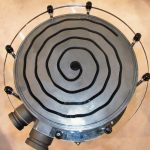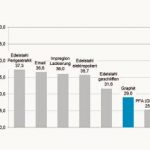The efficiency of heat exchange processes, and thus their economic efficiency, is principally influenced by the overall heat transfer values of the heat transfer device. Fouling in heat exchangers significantly impair this heat transfer. The risk of contamination can be considerably reduced with the wavy-groove heat exchanger. Thus maintenance costs can be cut and stable efficiency of the process maintained.
Tobias Schnurpfeil
Fouling is one of the main problems during the use of heat transfer media in production processes. The presence of deposits in heat exchangers can result in drastic reductions in overall heat transfer. This performance loss can, for example in the case of plate heat exchangers, amount to over 50 % – even with very thin layers of deposits. Pressure losses also increase. In order to prevent these effects it is necessary to regularly rinse the apparatus – and, in the case of stubborn deposits, even dismantle it for mechanical or hydraulic cleaning. In addition to the potential production downtimes, the maintenance and repair costs for spare parts (such as seals), and the work involved are immense in such cases.
The risk of fouling is largely dependent on the media used, as well as on the selected design of the heat exchanger. With certain process media, the selection of the most suitable design and arrangement of the heat exchanger can be of decisive importance. The aim is to maintain flows that are as turbulent as possible within the framework of the permitted pressure loss. The risk of causing deposits is considerably reduced by improving overall heat transfer values, i.e. thermal performance. Correspondingly stronger turbulence also brings about an auto-cleaning effect in the heat exchanger.
Impregnated graphite withstands corrosive media
GAB Neumann exploited these facts during development of its wavy-groove heat exchanger. The functional method of this special heat exchanger is based on the proven annular-groove design, in which the flow channels for the product and service side pass over consecutive layers running through the apparatus in the form of a spiral. This generates a highly turbulent forced flow on both sides with comparatively low pressure loss. There are no dead spaces, which are particularly liable to fouling. The material used, impregnated graphite, is predestined for use in heat exchangers as a result of its universal chemical resistance and its excellent heat conductivity. Moreover, impregnated graphite has strong anti-adhesive properties as a result of its special molecular surface structure, despite having a relatively rough surface. It is thus even superior to glass or stainless steel regarding its adhesive values. The auto-cleaning effect in wavy-groove heat exchangers is further enhanced by an undulating design of the flow channels, so that the need for cleaning can be greatly reduced. This heat exchanger design is very successfully used during biofuel production or during the production of plastic fibres, among other applications.
Use during the production of biodiesel
The company AT Agrartechnik in Schlaitdorf, Germany, employs wavy-groove heat exchangers, among others. In addition to the planning and construction of biodiesel plants worldwide, AT Agrartechnik is also a stakeholder in numerous user companies and thus has first-hand knowledge of the advantages of this heat exchanger design. Oxidation and polymer products were quickly deposited in the plate heat exchangers originally used, causing a range of undesirable secondary reactions. In order to prevent this, the plate heat exchangers had to be rinsed several times a week and, in many cases, even mechanically cleaned. Mechanical cleaning, in particular, causes significant costs, e.g. through renewed sealing or the replacement of plates damaged during dismantling. The use of wavy-groove heat exchangers allowed the rinsing frequency to be considerably reduced. Thus the heat exchangers are only rinsed once a month. This can be carried out within the framework of a planned plant standstill without unscheduled stoppages. No mechanical cleaning has been necessary since their commissioning. “The wavy-groove heat exchanger from GAB Neumann is the best solution for our application available on the market,“ confirms Dr. Ralf Türck, Project Manager at AT Agrartechnik. As a result of this very positive experience, AT Agrartechnik is using wavy-groove heat exchangers in a variety of other plants.
A further area of use is the production of plastic fibres. Working with sulphuric acid spinning baths necessitates the use of impregnated graphite as a heat exchanger material because of the corrosion caused. These processes also make significant demands of the anti-fouling properties of the heat exchanger. The wavy-groove heat exchanger is also used successfully here.
Dimensioned and designed as required
Given the current procurement situation, graphite is also a very competitive material for constructing apparatus, even with lower corrosion resistance requirements. This advantage is characterised by high heat conductivity, the possibility of utilising almost any duct geometries, and a comparatively low price.
The heat exchangers can be constructed with almost unlimited dimensions. The heat exchanger area can vary between 0.7 and 40 m². Larger areas are available on request. The heat exchanger is suitable for operating temperatures of between -60 and +200 °C, and for operating pressures from -1 to +6 bar (max. +10 bar). The average overall heat transfer coefficient of the wavy-groove heat exchanger is between 1200 and 1400 W/m²K, in permanent operation and assuming normal contamination.
Hall 3.0, Booth B32
cpp 431
More about the heat exchangers from GAB Neumann
Achema 2006
Share:








